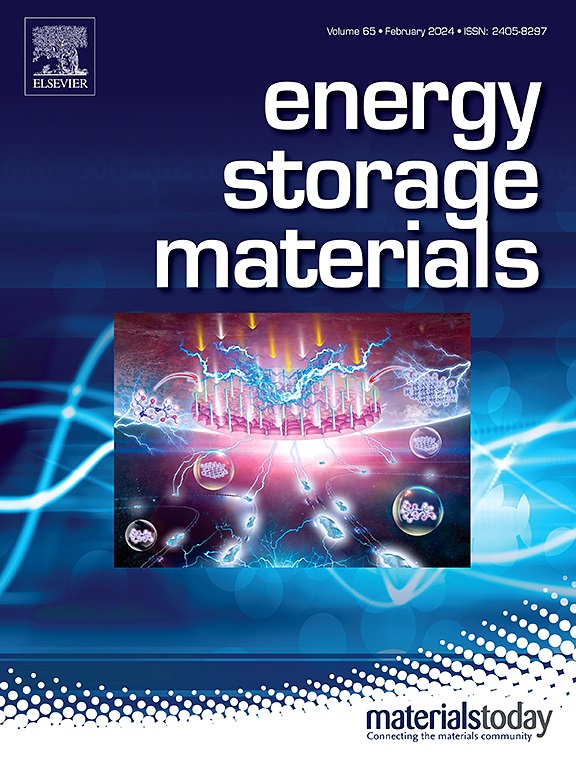Degradation behavior of Ah-level Li-ion pouch cell during repeated fast charging within a wide temperature region
IF 18.9
1区 材料科学
Q1 CHEMISTRY, PHYSICAL
引用次数: 0
Abstract
Quantifying the impact of temperature on the degradation behavior of the pouch cell during repeated fast charging is crucial for improving its fast-charging performance, especially in extreme conditions. Here, critical factors including electrochemical behavior, dynamic limitation, interfacial chemistry, structure evolution, and gas production affecting the battery degradation mechanisms have been explored and quantified based on the Ah-level LiNi0.5Co0.2Mn0.3O2||graphite pouch cells. The battery delivers high specific capacity and acceptable reversibility in the early cycles at 50 °C, and capacity decay occurs with the increased cycles; at 0 °C, the battery shows high polarization, low specific capacity, and poor cycle stability. As revealed by electrochemical analysis, the battery performance at 0 °C is mainly limited by the sluggish interfacial kinetics and the uneven SEI layer with a low proportion of LiF and a high content of LixOy. In contrast, high temperature accelerates the side reaction between electrolyte and cathode, inducing electrolyte decomposition, gas generation, and mechanical pulverization. Moreover, theoretical simulation reveals that the average cell temperature at 273 K is the highest. Both NCM523 cathode and graphite anode at 273 K have the greatest stress and deformation after one cycle at 8C, and the most cracks found on the cycled NCM523 particles at 323 K are mainly due to its severe side reaction. Based on these results, strategies for achieving fast-charging LIBs at extreme conditions can be proposed.
在反复快速充电过程中,量化温度对袋式电池降解行为的影响对于提高其快速充电性能至关重要,尤其是在极端条件下。本文以 Ah 级镍钴锰酸锂 0.5Co0.2Mn0.3O2|| 石墨袋电池为基础,探讨并量化了影响电池降解机制的关键因素,包括电化学行为、动态限制、界面化学、结构演变和气体产生。该电池在 50°C 下的早期循环中具有较高的比容量和可接受的可逆性,随着循环次数的增加,容量出现衰减;在 0°C 下,电池显示出较高的极化、较低的比容量和较差的循环稳定性。电化学分析表明,电池在 0°C 时的性能主要受限于缓慢的界面动力学和不均匀的 SEI 层,其中 LiF 的比例较低,LixOy 的含量较高。相反,高温会加速电解质和阴极之间的副反应,导致电解质分解、气体生成和机械粉碎。此外,理论模拟显示,273 K 时的电池平均温度最高。273 K 下的 NCM523 阴极和石墨阳极在 8C 下循环一次后的应力和变形都最大,而在 323 K 下循环的 NCM523 颗粒上发现的裂纹最多,主要是由于其严重的副反应造成的。根据这些结果,可以提出在极端条件下实现快速充电 LIB 的策略。
本文章由计算机程序翻译,如有差异,请以英文原文为准。
求助全文
约1分钟内获得全文
求助全文
来源期刊

Energy Storage Materials
Materials Science-General Materials Science
CiteScore
33.00
自引率
5.90%
发文量
652
审稿时长
27 days
期刊介绍:
Energy Storage Materials is a global interdisciplinary journal dedicated to sharing scientific and technological advancements in materials and devices for advanced energy storage and related energy conversion, such as in metal-O2 batteries. The journal features comprehensive research articles, including full papers and short communications, as well as authoritative feature articles and reviews by leading experts in the field.
Energy Storage Materials covers a wide range of topics, including the synthesis, fabrication, structure, properties, performance, and technological applications of energy storage materials. Additionally, the journal explores strategies, policies, and developments in the field of energy storage materials and devices for sustainable energy.
Published papers are selected based on their scientific and technological significance, their ability to provide valuable new knowledge, and their relevance to the international research community.
 求助内容:
求助内容: 应助结果提醒方式:
应助结果提醒方式:


